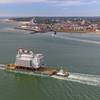Seaway Concludes 50th Anniversary Season
The St. Lawrence Seaway concluded its 50th anniversary season on December 28 with the passage of the JW Shelley. The vessel transited the Iroquois Lock at 7:37 p.m. on route to Lake Ontario. The Seaway navigation season for 2009 spanned 274 days.
The Welland Canal, which has been in operation since 1932, remained open to navigation until December 30, as the CSL Tadoussac transited Lock 1 at 3:04 p.m. and cleared Port Weller entering Lake Ontario at 3:22 p.m.
Total Seaway cargo volume for 2009 is estimated to amount to 30.5 million tonnes, the lowest volume witnessed since the early 1960's. The 25% decrease in cargo volume compared to 2008 can be attributed to the depth of the recession, which sharply curtailed movements of iron ore and steel on the waterway.
“Given the Seaway's reliance upon the steel industry for a substantial portion of our business, the economic downturn during the last year has certainly impacted our traffic level” commented Richard Corfe, President and CEO of The St. Lawrence Seaway Management Corporation (SLSMC). “The depth of this downturn underscores the importance of the SLSMC's efforts to diversify our cargo base, and we are working diligently on a number of fronts to attain this goal”.
“While our core market will remain centered upon the transport of bulk commodities, we are working towards a future in which the Seaway will become more adaptive in nature, and able to welcome a wider variety of vessels carrying niche cargoes” continued Corfe. “Our efforts to this end focus on the development of Hands Free Mooring, which will eliminate the need for a vessel owner to invest in equipment it only requires when navigating through the Seaway, reduce vessel crewing requirements for lock transits, and enhance productivity and safety”.
Despite the economic downturn, the Seaway and its Highway H2O partners have not relented in their efforts to attract new cargo volumes. A series of business incentives were credited with bringing in 1.6 million tonnes of new cargo contributing over $2m in toll revenue for 2009. A pilot project sponsored by the Port of Hamilton demonstrated the utility of transporting specialized containers between Hamilton and Montreal via tug and barge, providing an alternative to busy road and rail links.
Notable progress was also made in ballast water management and efforts to prevent any new introductions of aquatic invasive species (AIS) via ocean going vessels entering Seaway waters. Recent studies by leading academics including Dr. Sarah Bailey from the Department of Fisheries and Oceans and Dr. Hugh MacIsaac from the University of Windsor reveal that no new species have been reported since 2006, the first time since 1965-1967 that there has been a three-year period without new AIS discoveries.
“The application of salt water flushing, while not a final solution, is clearly having the desired effect, giving vessels the ability to transit the Seaway without posing undue risks to the ecology of our waters” emphasized Terry Johnson, Administrator of the U.S. Saint Lawrence Seaway Development Corporation. “Our present efforts combined with the forthcoming introduction of U.S. Coast Guard ballast water treatment standards will ensure an orderly progression in the steps required to protect our system from ship borne threats.”
The Government of Canada’s recent announcement of its intention to remove the 25% duty on certain vessels brought into Canada also bodes well for the Seaway’s future. The ability of ship operators to cost effectively acquire vessels able to maximize the use of the Seaway’s existing locks will bolster the system’s competitiveness. New vessels, equipped with modern engines capable of burning low sulphur fuels and advanced ballast water management technology, will reinforce the existing bulk fleet and provide fresh options to further expand short-sea shipping initiatives.
“Let’s not lose sight of the promise that marine transportation holds as the lowest emitter of greenhouse gases per tonne mile, an advantage not to be taken lightly as our nations collectively face great pressure to reduce North America’s carbon footprint,” concluded Canadian CEO Corfe.











